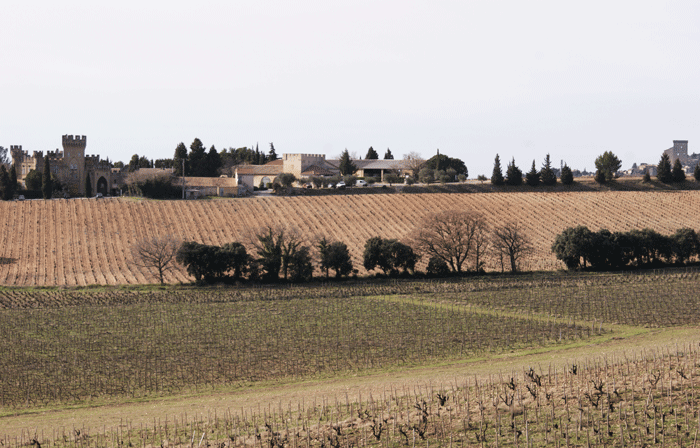Tasting Rhône 2012: the past, present and exceptional future of Château La Nerthe’s wines
Author: Eva Polaki
The striking main building of La Nerthe, at the top of a hill overlooking the vineyards, stands like a majestic Bordeaux château, with two towers and a chapel, and seems so firmly anchored in the landscape of Châteauneuf that it’s easy to suppose it must have been here for ever. Yet the earliest written references to the Château date from 1560 when it was called Grange de Beauvenir and was owned by the aristocratic family Tulle de Villefranche who, in turn, descended from the Piedmont region of Italy. The construction of the main building which is still standing today began in 1736, though some of its cellars date back to the 16th century.
In the mid-18th century, the wines of La Nerthe found recognition in the royal courts of France and beyond (a certain Thomas Jefferson bought a few cases). Notably, it was one of the first wine producers to employ estate bottling as early as 1784 to safeguard high quality of its wines.
The devastation caused in France by phylloxera forced the Tulle de Villefranche family in 1870 to sell out to Joseph Ducos, the Château’s eventual saviour – Ducos was the first French grower to import rootstock from America to overcome the vine plague.
Further adversity came during the Second World War, when the German occupying forces seized the Château to use as a supply centre. They ransacked its interiors and its wine cellars and also destroyed most of its historic documents. Miraculously, Château Nerthe’s main buildings survived the Royal Air Force raids unscathed, despite 22 bombs being dropped. (Two of the surviving RAF pilots involved in that bombardment went to visit the La Nerthe team a few years ago and declared their relief for having missed the target.)
After the war, while the buildings were restored the vineyards were neglected. In 1985, the declining Château was transformed into a flourishing operation thanks to the arrival of a former-accountant named Alain Dugas. After learning his craft on the 100-acre Côtes du Rhône Domaine de Renjarde, he eventually set his eyes on the bigger challenge of La Nerthe. In a joint venture with the Richard family (which has been involved in the wine trade since 1892), Dugas took on the Château. In 2008, Alain retired, and handed over the winemaking to Christian Voeux – previously, Christian had spent 24 years at the helm of Château Mont Redon in Châteauneuf-du-Pape.
Today, the Château spans over 90 hectares of slope vineyards on a broad spectrum of soils – mainly sandy and loam covered with a layer of the famed round stones. All 13 permitted grape varieties are grown, with Grenache in the majority.
The style
La Nerthe’s style is firmly in the modernist camp of accessible Châteauneufs. The reds have softer tannins than in Beaucastel or Vieux Télégraphe; the white wines show intense minerality, elegant fruit and round texture. On our visit, we were treated to a sumptuous, memorable lunch matched with a range of older vintages – all magnificent, deep, complex and astonishingly fresh and vibrant. Christian Voeux explained that they are one of the first to harvest in the region, to preserve freshness and fruit flavours. In his words the philosophy of La Nerthe is to “craft wines of finesse and complexity, rather than of power and extraction.”
La Nerthe’s signature white wine ages, in part, for half a year in vats and also in new oak barrels. A typical blend consists of 32 percent Grenache Blanc, 40-45 percent Roussanne, 7-12 percent Bourboulenc and 16 percent Clairette. The 2012 has lip-smacking freshness, with an underlying backbone of elegant fruit (peach, melon, grapefruit and hints of lime).
The mesmerising white Clos de Beauvenir is a truly unusual blend of 60 percent Roussane and 40 percent of Clairette, aged for 6 to 10 months on the grape skins in small new oak barrels. A richly textured, zesty wine with a savoury, salty tang and – courtesy of the Clairette – with a refreshing grapefruit acidity.
Château la Nerthe’s Rouge is a real flag-bearer for the region’s quality reds. The 2012 is a blend of 50 percent Grenache, 20 percent Syrah, 20 percent Mourvèdre, 5 percent Cinsault, and the rest a mixture of the other red varieties (Counoise, Mouscardin, Grenache Noir, Piquepoul Noir, Terret Noir, Vaccarese). Another glowing success, this possesses great intensity and nerve; an astonishing bouquet of spring flowers, truffles, blackberries, dark coffee and spice box soars from the glass. The palate shows an abundance of crunchy, peppery fruit, wrapped in suave tannins.
The Cuvée des Cadettes is the flagship, first introduced with the 1970 vintage. It is allegedly the first “Cuvee Speciale” to be offered in Châteauneuf and was originally labelled as “Grand Cru” (no longer so, as the appellation does not have delimited crus). The wine is sourced from old Grenache vines planted in 1893 in the eponymous granite plot just opposite the Château. The vines now look like bonsai trees and produce very low yields – about 2-3 bunches of fruit per plant. The wine is aged for one year, 80 percent of it in small new oak barrels, and is robust, fleshy and generous – the nearest a Rhône comes to a Pomerol!
The Clos de la Granière is a mixture of 45 percent Grenache, 24 percent Syrah, 18 percent Mourvèdre, 8 percent Cinsault, and 5 percent of the other varieties. It is made of the fruits of the younger (around 25-year-old) grapevines and ages for half a year in concrete tanks – a very small part in little oak barrels.



